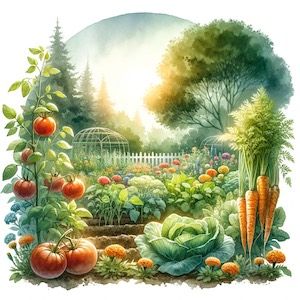1. What is companion planting? Companion planting is the practice of growing different plant species in close proximity for the mutual benefits they provide to each other, such as pest control, pollination, providing habitat for beneficial creatures, maximizing use of space, and increasing crop productivity.
2. How does companion planting work? Companion planting works by taking advantage of the natural attributes of plants to enhance the growth, flavor, and health of neighboring plants. This includes using certain plants to repel pests, attract beneficial insects, or provide nutrients, shade, or physical support.
3. Can companion planting help reduce pests? Yes, companion planting can help reduce pests by attracting beneficial insects that prey on pests, by repelling pests through natural substances emitted by certain plants, and by acting as a trap crop that lures pests away from more valuable plants.
4. What are some common companion plants for tomatoes? Common companion plants for tomatoes include basil, which can improve flavor and repel flies and mosquitoes, marigolds to deter nematodes, and borage to attract pollinators and deter tomato hornworms.
5. Why is marigold recommended in companion planting? Marigolds are recommended in companion planting because they release a substance from their roots that deters nematodes and other soil-borne pests, and their flowers can attract beneficial insects like ladybugs and lacewings.
6. Can I use companion planting in a small garden? Companion planting is highly beneficial for small gardens as it maximizes the use of limited space and can enhance the biodiversity which is crucial for the ecological health of the garden.
7. How do I choose companion plants for my garden? To choose companion plants, consider the needs of your primary plants in terms of light, water, and nutrient requirements, as well as which pests are common in your area. Look for companion plants that provide the benefits that your primary plants need. We have compiled a companion plant chart for your reference.
8. Can companion planting help with weed control? Yes, certain companion plants can help with weed control by providing ground cover to shade the soil, thereby preventing weeds from getting the sunlight they need to grow.
9. Is there scientific evidence supporting companion planting? There is some scientific evidence supporting companion planting, particularly in the areas of pest control and nutrient sharing. However, much of the knowledge is also based on anecdotal evidence and traditional practices.
10. How does companion planting affect soil health? Companion planting can improve soil health by diversifying the plant life in a garden, which can help prevent soil-borne diseases and improve soil structure and nutrient content.
11. Can companion planting save me money? Companion planting can save money by reducing the need for chemical fertilizers and pesticides, as it encourages natural pest control and nutrient sharing.
12. What are some companion plants to deter rabbits and deer? Plants like garlic, onions, and chives can deter rabbits and deer because of their strong scent. Additionally, thorny or prickly plants can physically discourage these animals from entering the garden.
13. Can companion planting help in a vegetable garden? Companion planting is especially beneficial in a vegetable garden as it can improve pollination, increase yields, enhance flavors, and reduce pests and diseases naturally.
14. Are there any plants that should not be grown together? Yes, some plants can inhibit the growth of others, known as allelopathy. For example, black walnut trees release juglone, which can be harmful to plants like tomatoes, potatoes, and eggplants.
15. Can herbs be used in companion planting? Herbs are excellent for companion planting because many have strong scents that can repel pests, and they can also attract beneficial insects with their flowers.
16. What are trap crops in companion planting? Trap crops are plants that are used to attract pests away from the main crop. For example, nasturtiums can be used to lure aphids away from other plants.
17. How does companion planting benefit pollinators? Companion planting benefits pollinators by providing a variety of flowering plants that offer nectar and pollen throughout the growing season.
18. Can companion planting help with crop rotation? Companion planting can complement crop rotation by maintaining a diverse range of species in the garden, which can help break pest and disease cycles.
19. How can companion planting help with water conservation? Companion planting can help with water conservation by using plants that provide shade, reducing evaporation, and by improving soil structure which enhances water retention.
20. Where can I find more information about companion planting? You can find more information about companion planting from university extension services, gardening books, online gardening forums and workshops, as well as from experienced gardeners in your local community. Many gardening websites and blogs also provide extensive information and guides on companion planting specific to various types of plants and regional climates.
For more tailored information, consider reaching out to your local cooperative extension service, which often offers resources and advice for gardeners looking to implement companion planting strategies that are suited to their local environment and conditions. Additionally, there are numerous books on the topic, with some focusing on organic gardening practices that heavily feature companion planting techniques. Online communities and forums can be a great place to ask questions and share experiences with other gardeners. Remember, while there’s a lot of information available, experimentation and observation in your own garden are invaluable for learning what companion planting pairs work best for you.
Additional companion plat links and info
- University of Massachusetts Amherst Center for Agriculture, Food, and the Environment: This website provides a detailed, research-backed guide to companion planting in the vegetable garden. It explores the science behind different plant interactions, including attracting beneficial insects, deterring pests, and optimizing nutrient management. https://ag.umass.edu/home-lawn-garden/fact-sheets/companion-planting-in-vegetable-garden
- Cornell University Cooperative Extension: This site offers a straightforward guide to companion planting principles, emphasizing the importance of diversity in the garden ecosystem. They also provide specific plant pairing recommendations for common vegetables and herbs. https://ulster.cce.cornell.edu/resources/companion-planting-and-flower-borders
- University of Delaware Cooperative Extension: This website features an informative article titled “The New Companion Planting: Adding Diversity to the Garden.” It discusses the evolution of companion planting practices and explores a variety of strategies for enriching your garden’s biodiversity. https://www.udel.edu/academics/colleges/canr/cooperative-extension/fact-sheets/adding-diversity-garden/
- Oregon State University Extension Service: This website offers a practical guide to companion planting for pest control, focusing on attracting beneficial insects and creating a thriving garden ecosystem. They also provide specific plant selections for various pest problems. https://extension.oregonstate.edu/gardening
- University of California Agriculture and Natural Resources: This website offers a research-based article titled “Understanding Companion Planting.” It critically examines the scientific evidence behind different companion planting claims and provides resources for further exploration. https://marinmg.ucanr.edu/EDIBLES/TECHNIQUES/










